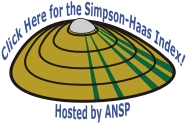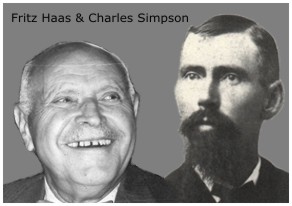The MUSSELp Simpson-Haas Index
NOTICE! After more than 8 years, The Simpson-Haas Index is longer supported. This page is just an archive of the original page. However, whereas the Simpson-Haas Index was just a subset of our data on the taxonomy of nominal species, the ENTIRE dataset is available by clicking here.
 The Simpson-Haas Index is a subset of the data compiled for the MUSSEL Project. "Simpson" refers to Charles T. Simpson, and "Haas" is of course Fritz Haas. Each of these 20th century freshwater malacologists developed global treatments of the Unionoida, and these works have served as an excellent starting point for the MUSSELpdb. The Index will be periodically updated as inconsistencies and spelling errors are discovered and corrected (both ours and theirs). The current version was posted 16 June 2005. The Simpson-Haas Index is a subset of the data compiled for the MUSSEL Project. "Simpson" refers to Charles T. Simpson, and "Haas" is of course Fritz Haas. Each of these 20th century freshwater malacologists developed global treatments of the Unionoida, and these works have served as an excellent starting point for the MUSSELpdb. The Index will be periodically updated as inconsistencies and spelling errors are discovered and corrected (both ours and theirs). The current version was posted 16 June 2005.
To which works does the Simpson-Haas Index refer?
At present, the three works of interest are:
- Simpson, C.T. 1900. Synopsis of the naiades, or pearly fresh-water mussels. Proceedings of the United States National Museum 22(1205):501-1044.
- Simpson, C.T. 1914. A descriptive catalogue of the naiades, or pearly fresh-water mussels. Parts I-III. Bryant Walker, Detroit, Michigan.
- Haas, F. 1969. Superfamilia Unionacea. Das Tierreich (Berlin) 88.
Also, just for fun, we have included:
- Haas, F. 1969. Superfamily Unionacea. pp. N:411-470. in R.C. Moore (ed.) Treatise on Invertebrate Paleontology. Geological Society of America and the University of Kansas. Part N, Vol. 1 (of 3), Mollusca.
What sort of information does the Simpson-Haas Index provide?
 The Simpson-Haas Index is a database of nominal unionoid species referred to by Simpson and/or Haas. A typical record looks something like this (see right). This is the record for Iridina ovata Swainson, 1840. The Simpson-Haas Index is a database of nominal unionoid species referred to by Simpson and/or Haas. A typical record looks something like this (see right). This is the record for Iridina ovata Swainson, 1840.
The complete original combination is provided, beginning with the trivial epithet. If any comments about the nomenclature of the nomen are available, they are provided parenthetically on the next line.
Relevant references to the original description and figures (if any) come next, followed by the subsequent combination used in the various references by Simpson and Haas included in the Index.
How do I retrieve data from the Simpson-Haas Index?
The Simpson-Haas Index basically functions by allowing the user to specify sets of records based on various criteria. The returned set can then be browsed page by page.
Browsing. There are few different ways for a user to specify a set of records, and the simplest is to browse. A navigation bar like the one below is provided to let you skip thru the various nominal species cited in Simpson and/or Haas. By simply clicking on a letter, those nominal species-group level taxa beginning with that letter are returned.
Clicking the page navigator moves the set of records shown forward or backward thru the whole set of records that match the criteria of the set.
 Searching. To specify more specific criteria, the user can manually search the "species" field of the original combination. A wild-card is automatically appended to the end of the specified search criterion, and that text is used to search for matches. Thus, all nominal species beginning with the search criterion will be returned. Searching. To specify more specific criteria, the user can manually search the "species" field of the original combination. A wild-card is automatically appended to the end of the specified search criterion, and that text is used to search for matches. Thus, all nominal species beginning with the search criterion will be returned.
Again, the page navigation bar can be used to click thru multiple pages if the number of records returned exceeds what can be shown on one screen.
Clicking. Most of the nominal species listed in the Simpson-Haas Index are related to other nominal species. For example, one name might be a spelling error or a homonym of another. A particular set of species might all be synonyms according to either Simpson or Haas. When such relationships exist, a link is provided that will return the set of associated records.
For example, in the sample record of Iridina ovata Swainson shown above, clicking one of the subsequent combinations will return the set of nominal species synonymized under than name.
What is not available from the Simpson-Haas Index?
A Guarantee. The MUSSELp database is definitely a work in progress. As such, much of the information provided herein has not been verified. Browse with confidence but don't be surprised if a few errors have crept in. They will be dealt with in due time.
Species Not in Simpson or Haas. The MUSSELp database stores information about all nominal species of freshwater mussels, not just those listed in Simpson and Haas. Eventually, everything will be available at this site, but until then, this is what we are providing. So, species described after 1969 are certainly excluded.
Simpson (1900, 1914) made clear that he was not going to include all of the species then described. For example, not all of the invalid names introduced by the French New School were listed. Moreover, both Simpson and Haas missed numerous available names. For example, those of Rafinesque. Some of these missed or intentionally excluded nomina may be in the Simpson-Haas Index with a comment that they were omitted.
 Who were Simpson and Haas? Who were Simpson and Haas?
Charles T. Simpson (1846-1932) of Illinois struck up a relationship with W.H. Dall at the Smithsonian Institution. Simpson was hired by the daughter and son-in-law of Isaac Lea to compile another Synopsis of the Unionoida, following the earlier ones set down Dr. Lea.
Fritz Haas (1886-1969) was curator of mollusks at the Senckenberg Museum in Frankfurt/M. until 1936. To escape Nazi Germany, Haas immigrated to the USA and worked as curator at the Field Museum in Chicago until 1959.
The works listed above by these two authors share the distinction of being the only 20th century global treatments of freshwater mussels to the species level. |